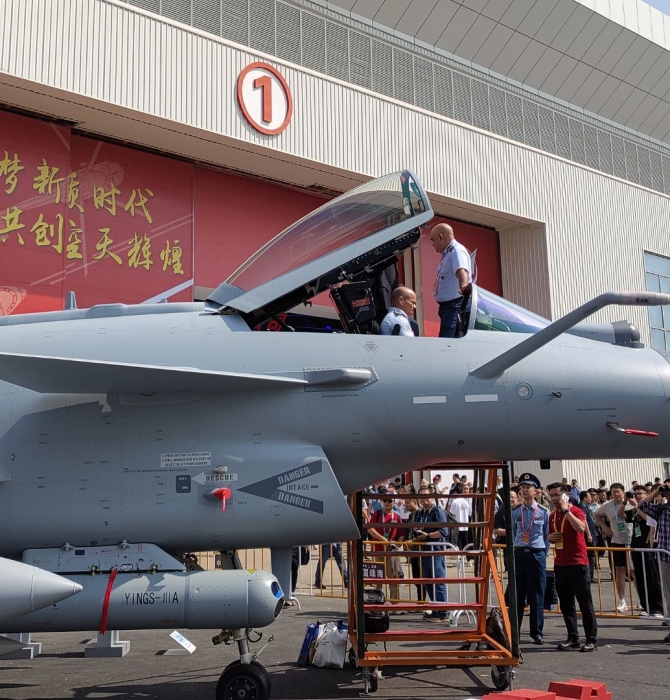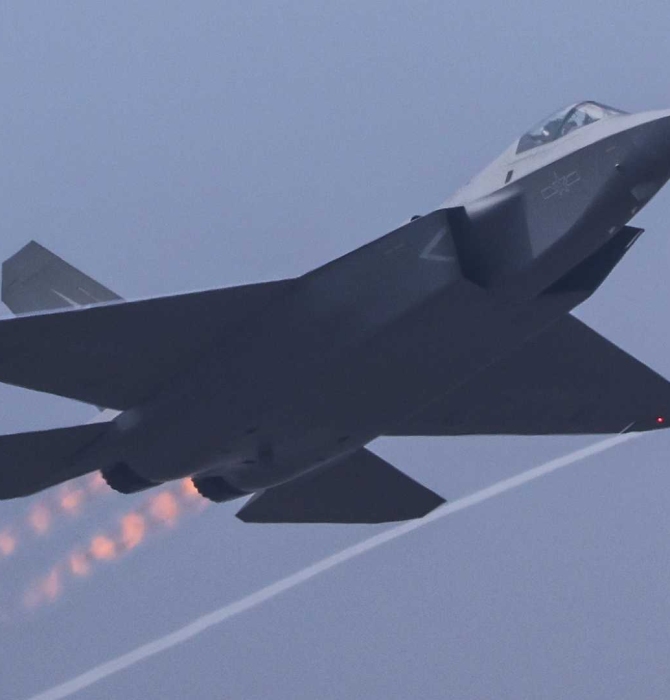10228Views
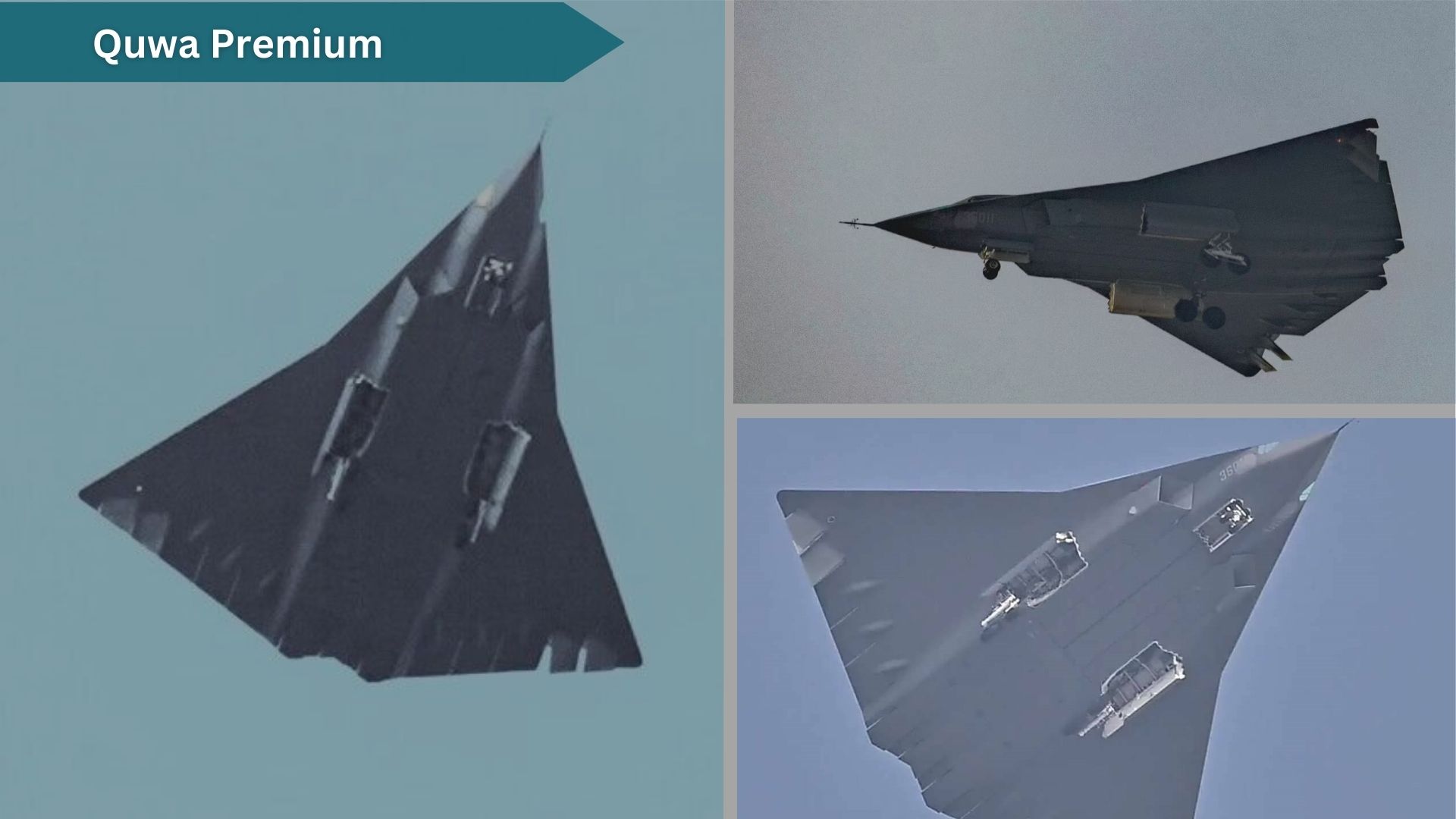
China Flies Chengdu J-36 Sixth-Generation Fighter Quwa Premium
On 26 December 2024, China surprised the world by flying not one, but two, new fighter prototypes embodying its vision for next-generation air systems, the Chengdu J-36 and the Shenyang J-XX/J-50.
Through a series of controlled leaks, China revealed a relatively large tailless diamond-wing design from Chengdu dubbed the J-36 (based on its airframe number #36011) and a smaller, but still large, tailless “lambda-wing” platform Shenyang (unofficially called J-XX or J-50).
While it was known that China had been developing a so-called ‘sixth-generation’ combat aircraft system, the reveal of both the J-36 and J-XX/J-50 was surprising. First, few would have expected China to show such platforms before the United States, which had initially championed the concepts involved in sixth-gen combat aircraft via its Next Generation Air Dominance (NGAD) program. Second, China revealed two different fighter programs with parallel research, development, and production tracks.
Putting it bluntly, China revealed both the world’s first and second sixth-generation fighter aircraft within a matter of hours of each other. The year of 2025 has arguably opened with China becoming the focal point of global defence aviation.
A Surprise Reveal on Boxing Day
This article will focus on the design and impacts of the Chengdu Aerospace Corporation (CAC) J-36, the first of the newly revealed combat aircraft.
Based on the available photos and video footage, the J-36 leverages a tailless diamond or flying wing design. The J-36 is powered by three turbofan engines and, when viewed alongside the CAC J-20, is a markedly larger platform.
Some analysts peg the J-36’s length to be around 75 ft or nearly 23 m and wingspan at 63 ft or 19.2 m[1]. In comparison, the J-20 has a length of 66.6 m or 20.3 m and wingspan of 42.3 ft or 12.88 m[2]. Therefore, the J-36 may have a maximum take-off weight (MTOW) ranging from 50 tons to 60 tons[3].
The use of three turbofan engines is unlikely just for ferrying a large platform; rather, the power output likely plays many key roles. This (as discussed later in the article) probably includes energy generation for a vast electronic loadout ranging from long-range radar or other sensor arrays as well as directed energy weapons (DEW).
On a first look, one might confuse the J-36 as a long-range strike fighter. However, when one reviews the statements of Chinese officials – including CAC’s chief designer – CAC’s J-36 is more than just a new fighter. Rather, it is the focal point of China’s vision for how future air combat is materializing and, potentially, a goalpost for the rest of the world.
China’s Sixth-Generation Fighter Aircraft Play
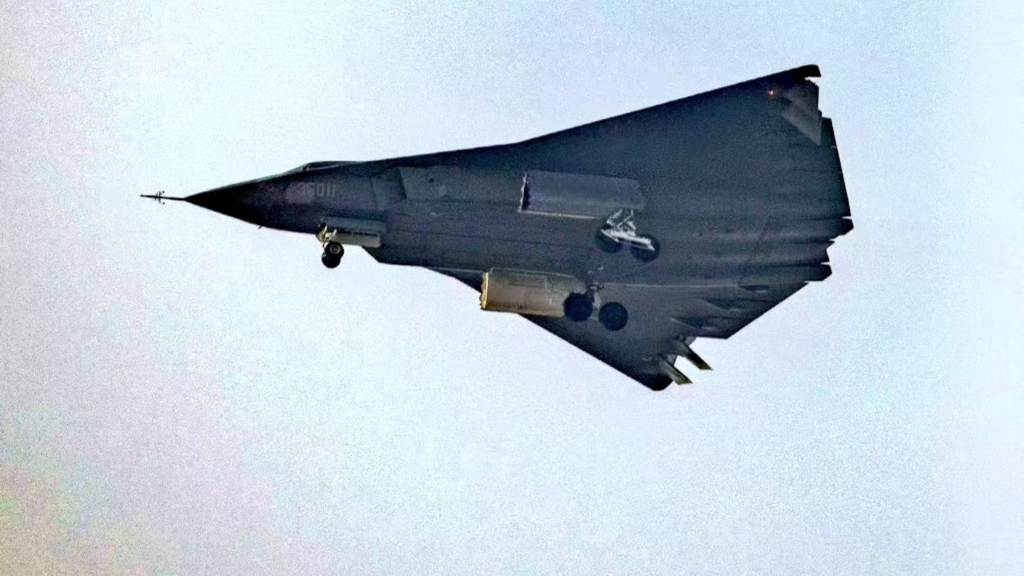
Admittedly, the term ‘sixth-generation fighter aircraft’ is nebulous or vague, and can be used to mean different things to different parties. However, it increasingly seems as if America’s Next-Generation Air Dominance (NGAD) concept is informing a general consensus of some must-have attributes for sixth-generation fighters.
These attributes include a native level of compatibility with DEWs, such as high-energy lasers (HEL) and high-powered microwave (HPM) weapons, or the capacity to lead or manage manned-unmanned teaming (MUM-T) formations involving drones.
Given the design of the Chengdu J-36 and China’s broader development work across unmanned combat aerial vehicles (UCAV), DEWs, electronic warfare (EW), and smart munitions, the J-36 aligns with the high-level concepts for sixth-gen fighters.
Potential Origins of the J-36
Chinese officials began speaking about the People’s Liberation Army’s (PLA) vision for next-generation air warfare in the late 2010s. In 2019, the chief designer at CAC, Wang Haifeng, stated that development work on a sixth-generation fighter was underway with an emphasis to “protect the sea and sky” by 2035[4].
Wang Haifeng had emphasized that elements like MUM-T, use of artificial intelligence (AI), omnidirectional sensors, and improved stealth would all be relevant factors[5].
China’s Response to America’s NGAD
Conceptually, the Chinese seemed to have executed a few of the concepts the U.S. had spoken of with NGAD. In 2022, Gen. Kelly believed that China would focus on a few key areas, such as greatly reducing aircraft radar visibility, accelerating processing power for sensors, and iterating very rapidly using open mission systems.
Ironically at the time, Gen. Kelly stated that China would often focus on iterating within a platform and, in turn, drive capabilities slower than the U.S. In contrast, Kelly’s claim was that the U.S. focused on large capability jumps.
However, the emergence of the CAC J-36 and the SAC J-XX/J-50 puts that assertion – and American-held assumptions about Chinese aerospace development up to this point – to the wayside. China has taken the concepts driving the NGAD and sixth-gen fighter development broadly, and materialized them years ahead of all other countries.
Earlier Signs of Progress
Until this point, analysts had estimated that China would probably carry out the maiden test flight of its sixth-generation fighter around 2028[7].
In 2021, observers spotted a mysterious prototype or demonstrator of a tailless combat aircraft at CAC’s facilities using satellite imagery[8]. It is unclear if this aircraft was a J-36 unit, but the CAC project at the time certainly contributed to the flying prototype.
By 2022, then commander of the USAF’s Air Combat Command (ACC) General Mark D. Kelly warned that China’s sixth-generation program was materializing, stating: “I can tell you what’s not happening. They’re not having a debate over the relevance of six-gen air dominance. And I can also tell you they’re on track.”[9]
Therefore, the progressive indicators (and warning signs from USAF) were emerging, and the test flights at the end of 2024 were surprising for occurring three years earlier than expected. But China gaining sixth-generation fighter aircraft around the time of its peers (including the U.S., which aimed to go live by 2030) was not in question.
Chengdu J-36 Design
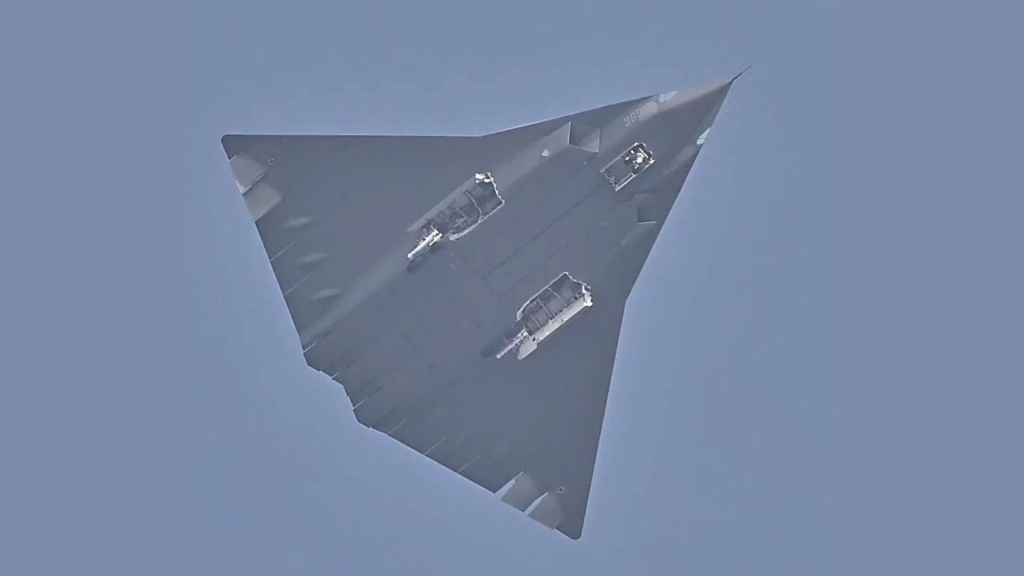
During the 2022 Zhuhai Air Show, the Chinese industry offered an indication as to the direction the PLA could take with its next-generation fighters.
For example, the display below largely embodies many of the airframe design characteristics now seen in the J-36 (bar the third engine).
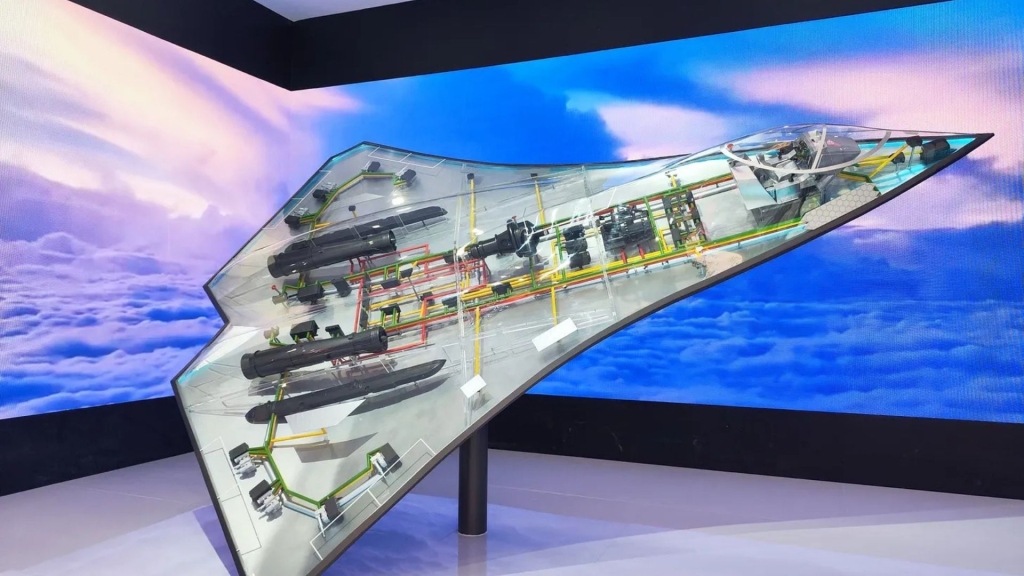
Tailless Flying Wing Airframe
The J-36 leverages a tailless diamond-wing fuselage. This approach omits the need for vertical stabilizers, reducing the aircraft’s radar cross-section (RCS) while also improving the aircraft’s drag and fuel efficiency. These design attributes indicate that China nurtured a credibly strong technology base for advanced flight control systems. Its expertise in the area has reached a point where it does not need to incorporate traditional tailplanes.
Three-Engine Configuration
One of the unique and unexpected aspects of the J-36 is that it relies on three turbofan engines. Currently, these engines might be the WS-10C, but this may be a transitional or temporary solution until a more advanced powerplant is available.
Chengdu may be waiting for the WS-15 to become available, which reportedly provides both supercruising and a greater thrust for an improved thrust-to-weight ratio. However, it is worth noting that the choice for three engines may not be due to the size of the aircraft alone, but to achieve a specific capability set in the future.
Basically, three engines would allow the J-36 to generate significant electrical power, a key need for supporting its advanced avionics, different sensors, high-output EW systems, and, potentially, DEWs such as HELs and/or HPMs.
In other words, the choice for three engines has less to do with sustaining the J-36’s size or weight (as one might assume with a traditional design approach), but to enable its role in China’s next-generation air warfare vision. In this context, the J-36 would serve as both a focal node managing a formation of UCAVs, smart munitions, and other assets as well as a long-range, high-performance stand-alone combat aircraft.
In fact, even if one were to restrict the J-36 to solely being a focal node for managing or leading MUM-T formations, the effective use of that could rely on electronics. Basically, to manage drones at scale, one would need onboard extensive computational power, and to run that alongside high-powered data-links for two-way communication will require lots of energy. This electronics stack would not only involve the processing as well as sensor or radio arrays, but also the required cooling systems.
The way a fighter generates electricity is through its engine(s). In theory, perhaps, one or two engines could be sufficient if the platform’s roles were restricted to specific missions, such as MUM-T alone or only deploying DEWs. However, it seems that China is working to make each J-36 an individually versatile system, one that can play multiple key – and, to be clear, power-intensive – roles to support UCAVs and smaller crewed assets.
To support this mission, it is possible that the J-36 – or some future variant – could adopt a variable-cycle engine (VCE). VCEs enable individual turbines to spin at different or varied speeds rather than one fixed speed for all. It can lead to better fuel efficiency and may tie into supporting other power-needs better, such as those of electronic subsystems.
Large Size and Internal Volume
The potential MTOW of the J-36 could be from 50 tons to 60 tons, making it significantly larger than traditional strike fighters. This large size likely translates into significant fuel volume and large internal weapon bays, enabling for long-ranges and heavy payloads.
Currently, one can only speculate as to the range and payload specifications. However, one can infer that China’s principal goal in terms of reach is to be able to cover the first island chain, i.e., Japan, Taiwan, Philippines, and Indonesia. Thus, a combat radius for covering the first island chain – ideally without mid-air refueling – could be expected. In turn, the use of long-range stand-off weapons (SOW) can help extend the J-36’s strike and impact reach to potentially the second island chain (i.e., all of Indonesia).
From a payload standpoint, one can expect the J-36’s internal weapons bay to support a wide assortment of munitions, from new air-to-air missiles – like the ultra-long-range PL-17 with a speculated range of over 300 km [11] – to precision-guided glide bombs (PGB) and air-launched cruise missiles (ALCM).
However, munitions may not be the sole purpose of the weapons bay, even if it can carry a large payload. Rather, the internal weapons bay could be used to house DEWs and other non-kinetic equipment. Moreover, instead of carrying its own munitions, the J-36 may use its electrical output to leverage new high-powered data-links and, in turn, coordinate UCAVs to deploy their munitions.
Once again, the point of the J-36 is not to treat it as a traditional fighter, but a focal node in a wider air combat system. This system will include UCAVs of varying sizes, possibly including relatively large drones that may match up to small crewed fighters in size.
For its own ‘weapons’ complement, the J-36 may eschew traditional munitions and lean on DEWs instead. Its three-engine configuration speaks to a focus on power output, one of the key constraints (alongside the size of the housing platform) of many DEW types.
Potential Performance Capabilities
Of course, the J-36 seems to leverage its own unique performance advantages. For one thing, its three-engine configuration and ‘slimmer’ airframe may result in both a stealthier and more aerodynamic design. In terms of the latter, the J-36 could potentially be able to fly at high speed (at least Mach 2), giving it a ‘stealth-and-speed’ advantage.
This can be used to ensure the J-36 is difficult to track and engage, which, in turn, makes it harder to neutralize a MUM-T formation led or managed by this fighter. In addition, the J-36 could also leverage its own EW suite to jam radars – including those on seekers – and, potentially, communications between enemy air assets.
One could potentially see a scenario where the J-36 operates at high-altitudes and flies at high speeds. In parallel, the Shenyang J-XX/J-50 could be the slower, maneuverable, and lower-flying threat for more traditional fighter-type operations, like long- and/or short-range air-to-air engagements and combat air patrols (CAP), for example.
What Makes the Chengdu J-36 a ‘Sixth-Gen’ Fighter?
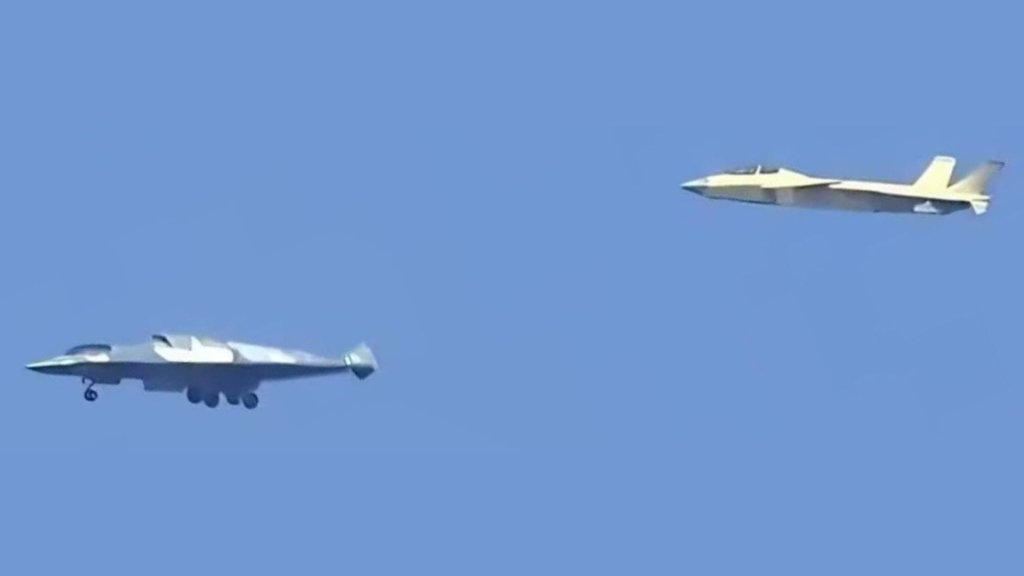
To reiterate, there is no consensus on the specifics of what constitutes a ‘sixth-generation fighter’ (6GFA). However, the Chengdu J-36 (and Shenyang J-XX/J-50) both carry specific airframe design elements that make them distinct and much improved over all other current generation aircraft, including America’s cutting-edge platforms, like the F-35…
End of excerpt (2,045/4,296 words)
Existing Quwa Premium members can log in below
Note: Logged in members may need to refresh the article page to see the article.
Sources
- Bill Sweetman. “Boxing clever? China’s next-gen tailless combat aircraft analysed.” Royal Aeronautical Society. 26 December 2024. URL: https://www.aerosociety.com/news/boxing-clever-chinas-next-gen-tailless-combat-aircraft-analysed/
Ibid.
Ibid.
“China remains coy on its sixth-generation fighter program.” ANI News. 15 July 2024. URL: https://www.aninews.in/news/world/asia/china-remains-coy-on-its-sixth-generation-fighter-program20240715163921/
- Ibid.
Valerie Insinna. “China ‘on track’ for 6th-gen fighter, US Air Force needs to get there first: ACC chief.” Breaking Defense. 26 September 2022. URL: https://breakingdefense.com/2022/09/china-on-track-for-6th-gen-fighter-us-air-force-needs-to-get-there-first-acc-chief/
- Ibid.
Tyler Rogoway. “Tailless Fighter-Like Airframe Spotted at Chinese Jet Manufacturer’s Test Airfield.” The Warzone. URL: https://www.twz.com/42937/tailless-fighter-like-airframe-spotted-at-chinese-fighter-jet-manufacturers-test-airfield
Valerie Insinna. “China ‘on track’ for 6th-gen fighter, US Air Force needs to get there first: ACC chief.” Breaking Defense. 26 September 2022. URL: https://breakingdefense.com/2022/09/china-on-track-for-6th-gen-fighter-us-air-force-needs-to-get-there-first-acc-chief/
- Ibid
Justin Bronk. “Russian and Chinese Combat Air Trends.” Whitehall Report 3-20. Royal United Services Institute (RUSI). URL: https://static.rusi.org/russian_and_chinese_combat_air_trends_whr_final_web_version.pdf

